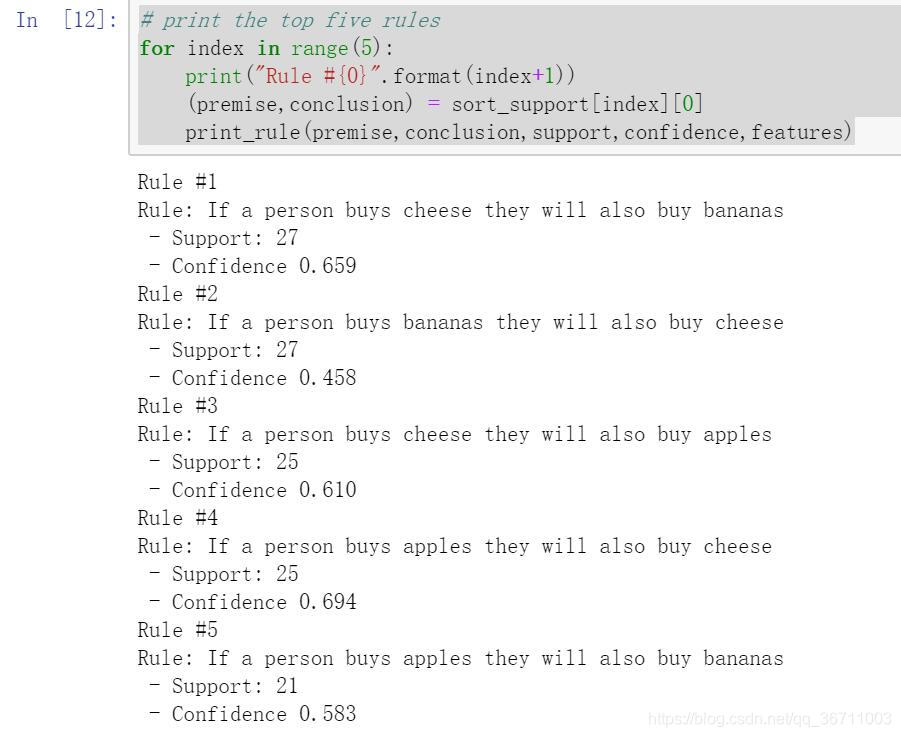数据挖掘初识-简单例子
title: 数据挖掘初识-简单例子date: 2018-10-22 20:31:06updated: 2018-10-22 20:31:06description: 关联度分析+鸢尾花分类categories: 机器学习photo:tags:data mingmusic-id:password:math:关联度分析关联度分析是指给出物品或对象的相似度。主要有以下的...
·
关联度分析
关联度分析是指给出物品或对象的相似度。主要有以下的应用场景。
- 给目标受众提供不同的服务或者广告
- 电影推荐或者淘宝商品推荐
- 基因分析,发现共同的祖先
物品推荐
为了简化代码,我们只同时考虑两个物品。比如用户A买了牛奶和面包。我们希望遵循一个原则:如果用户A买了X,那么他很有可能也买Y。
加载数据集
import numpy as np
file = "affinity_dataset.txt"
X = np.loadtxt(file)
n_samples,n_features = X.shape
print("This dataset has {0} samples and {1} features".format(n_samples,n_features))
# the name of your features
features=["bread","milk","cheese","apples","bananas"]
使用排序规则
我们希望根据上面的简单规则:**如果用户A买了X,那么他很有可能也买Y。**去选择合适的规则来给用户进行推荐。而规则的选择主要根据支持度和置信度来判断。
- Support(支持度):表示同时包含A和B的事务占所有事务的比例。如果用P(A)表示使用A事务的比例,那么Support=P(A&B)
- Confidence(可信度):表示使用包含A的事务中同时包含B事务的比例,即同时包含A和B的事务占包含A事务的比例。公式表达:Confidence=P(A&B)/P(A)
- Support表示规则发生频率,而Confidence表示规则使用的准确度。
# how many rows contain our premise(前提: that a person is buying apples
num_apples_purchases = 0
for sample in X:
if sample[3] == 1:
num_apples_purchases += 1
print("{0} people bought apples".format(num_apples_purchases)
# 36 people bought apples
# how many of the cases that a person bought an apple involved with bananas?
# record both cases where the rule is valid or invalid
valid_rules = 0
invalid_rules = 0
for sample in X:
if sample[3] == 1:
if sample[4] == 1:
valid_rules += 1
else:
invalid_rules += 1
print("{0} cases of valid rules were discovered".format(valid_rules))
print("{0} cases of invalid rules were discovered".format(invalid_rules))
# 21 cases of valid rules were discovered
# 15 cases of invalid rules were discovered
#compute the support and confidence
support = valid_rules
confidence = support / num_apples_purchases
print("The support is {0} and the confidence is {1:.3f}".format(support,confidence))
print("As a percentage, the confidence is {0:.1f}%".format(confidence*100))
# The support is 21 and the confidence is 0.583
# As a percentage, the confidence is 58.3%
计算所有规则的Support 和 Confidence
from collections import defaultdict
valid_rules = defaultdict(int)
invalid_rules = defaultdict(int)
num_occurances = defaultdict(int)
#iterate over each sample and feature
for sample in X:
for premise in range(n_features):
# 如果前提条件不存在,比如如果我们买了苹果
if sample[premise] == 0:
continue
num_occurances[premise] += 1
# 结论,同时我们买了牛奶
for conclusion in range(n_features):
# 如果买了苹果,同时买了苹果
if premise == conclusion:
continue
if sample[conclusion] == 1:
valid_rules[(premise,conclusion)] += 1
else:
invalid_rules[(premise,conclusion)] += 1
support = valid_rules
confidence = defaultdict(float)
for premise,conclusion in valid_rules.keys():
rule = (premise,conclusion)
confidence[rule] = valid_rules[rule] / num_occurances[premise]
for premise, conclusion in confidence:
premise_name = features[premise]
conclusion_name = features[conclusion]
print("Rule: If a person buys {0} they will also buy {1}".format(premise_name, conclusion_name))
print(" - Confidence: {0:.3f}".format(confidence[(premise, conclusion)]))
print(" - Support: {0}".format(support[(premise, conclusion)]))
print("")
排序发现最好的规则
# rank the best rule
# because of the dict do not support by odering,the items() give us a list
# using itemgetter(1) which allows the sorting based on the values
from operator import itemgetter
sort_support = sorted(support.items(),key = itemgetter(1),reverse=True)
print(sort_support)
# print the top five rules
for index in range(5):
print("Rule #{0}".format(index+1))
(premise,conclusion) = sort_support[index][0]
print_rule(premise,conclusion,support,confidence,features)
# based on the confidence
print(confidence.items())
sort_confidence = sorted(confidence.items(),key = itemgetter(1),reverse = True)
for index in range(5):
print("Rule #{0}".format(index+1))
precise,conclusion = sort_confidence[index][0]
print_rule(precise,conclusion,support,confidence,features)
结果展示


鸢尾花分类
分类问题主要有以下应用场景:
- 判定植物种类
- 判定图片是不是为狗
- 判定病人是不是患了癌症根据已有的测试数据…
加载数据集
import numpy as np
from sklearn.datasets import load_iris
dataset = load_iris()
X = dataset.data
y = dataset.target
print(dataset.DESCR)
n_samples,n_features = X.shape
# comnpute the mean for each feature
feature_mean = X.mean(axis = 0)
# 断言语句
assert feature_mean.shape == (n_features,)
X_d = np.array(X >= feature_mean,dtype='int')
print(X_d)
# split the dataset to the train_data and test_data
from sklearn.cross_validation import train_test_split
random_state = 14
X_train,X_test,y_train,y_test = train_test_split(X_d,y,random_state = random_state)
print("There are {0} training samples".format(y_train.shape))
print("There are {0} test samples".format(y_test.shape))
使用OneR算法
OneR的思路很简单,建立一个只针对于单个属性进行测试的规则,并进行不同的分支。每个分支对应的不同属性值。
分支的类就是原始数据(训练数据)在这个分支上出现最多的类。
每一个属性都会产生一个不同的规则集,每条规则对应这个属性的每个值。对每个属性值的规则集的误差率进行评估,选择效果最好的一个即可。
伪代码表述:
对于这个属性的每个属性值,建立如下规则
- 计算每个类别出现的频率
- 找出出现最频繁的类别找出出现最频繁的类别
- 建立规则,将这个类别赋予这个属性值建立规则,将这个类别赋予这个属性值
- 计算规则的误差率计算规则的误差率
- 选择误差率最小的规则选择误差率最小的规则
比如,如果特征X有两个值0,1。对于0,我们发现有20个是属于A,60个属于B,20个属于C。那么对于X = 0的预测是属于A,有40/100 = 0.4的误差。
from collections import defaultdict
from operator import itemgetter
# use the oneR algorithm
#训练特征的值
def train_feature_value(X,y_true,feature,value):
# count the actual classes for each sample with that feature value
class_counts = defaultdict(int)
for sample,y in zip(X,y_true):
if sample[feature] == value:
class_counts[y] += 1
# find the most frequently assigned class by sorting the class_counts
sort_class_counts = sorted(class_counts.items(),key=itemgetter(1),reverse = True)
most_frequent_class = sort_class_counts[0][0]
# compute the error
# The error is the number of samples that do not classify as the most frequent class
incorrect_predictions = [class_count for class_value,class_count in class_counts.items() if class_value != most_frequent_class]
error = sum(incorrect_predictions)
return most_frequent_class,error
def train(X,y_true,feature):
"""Computes the predictors and error for a given feature using the OneR algorithm
Parameters
----------
X: array [n_samples, n_features]
The two dimensional array that holds the dataset. Each row is a sample, each column
is a feature.
y_true: array [n_samples,]
The one dimensional array that holds the class values. Corresponds to X, such that
y_true[i] is the class value for sample X[i].
feature: int
An integer corresponding to the index of the variable we wish to test.
0 <= variable < n_features
Returns
-------
predictors: dictionary of tuples: (value, prediction)
For each item in the array, if the variable has a given value, make the given prediction.
error: float
The ratio of training data that this rule incorrectly predicts.
"""
# Check that variable is a valid number
n_samples, n_features = X.shape
assert 0 <= feature < n_features
# Get all of the unique values that this variable has
values = set(X[:,feature])
# Stores the predictors array that is returned
predictors = dict()
# store the errors for each feature value
errors = []
# iterate over all the unique feature values to find most_frequent_class and error
for cur_value in values:
most_frequent_class,error = train_feature_value(X,y_true,feature,cur_value)
predictors[cur_value] = most_frequent_class
errors.append(error)
total_error = sum(errors)
return predictors,total_error
# compute all the predictors and errors for the features
all_predictors = {}
errors = {}
for feature in range(X_train.shape[1]):
predictors,total_error = train(X_train,y_train,feature)
all_predictors[feature] = predictors
errors[feature] = total_error
# find the best feature with the lowest error
best_feature,best_error = sorted(errors.items(),key=itemgetter(1))[0]
print("The best model based on the feature {0} and its error {1:.2f}".format(best_feature,best_error))
模型结果
# create our model bt storing the predictors for the best feature
# The model is a dict thate tells us which feature to use for One Rule and the predictions that are made based on the value it has.
model = {'feature':best_feature,'predictor':all_predictors[best_feature]}
print(model)
# 预测测试集
def predict(X_test,model):
feature = model['feature']
predictor = model['predictor']
y_predicted = np.array([predictor[int(sample[feature])] for sample in X_test])
return y_predicted
y_predicted = predict(X_test,model)
print(y_predicted)
# compute the accuracy
accuracy = np.mean(y_predicted == y_test)*100
print("The test accuracy is {0:.1f}%".format(accuracy))
由于模型构造比较简单,所以准确率也就只有65.8%。
更多推荐
 已为社区贡献3条内容
已为社区贡献3条内容








所有评论(0)